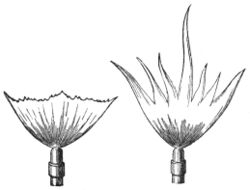Sensitive flame
A sensitive flame is a gas flame which under suitable adjustment of pressure resonates readily with sounds or air vibrations in the vicinity.[1] Noticed by both the American scientist John LeConte and the English physicist William Fletcher Barrett, they recorded the effect that a shrill note had upon a gas flame issuing from a tapering jet. The phenomenon caught the attention of the Irish physicist John Tyndall who gave a lecture on the process to the Royal Institution in January 1867.[2]
While not necessary to observe the effect, a higher flame temperature allows for easier observation. Sounds at lower to mid-range frequencies have little to no effect on the flame. However, shrill noises at high frequencies produce noticeable effects on the flame. Even the ticking of a pocket watch was observed as producing a high enough frequency to affect the flame.[3]
See also
- Pyrophone
External links
- YouTube clip UCL Phonetics Laboratory 1920s
- "The Effect of Inaudible Vibrations upon Sensitive Flames" - W. F. Barrett - Nature (1877)
- "The Bunsen Flame: a Sensitive Flame" - W. W. Haldare Gee - Nature (1878)
- Sensitive Flames, Popular Science (1874)
References
- ↑ Stand and Burner for Sensitive Flames - Prof. W. F. Barrett
- ↑ "Les Recreations Scientifiques" - Gaston Tissandier
- ↑ "Sensitive Flames and Sound-Shadows". Popular Science. https://en.wikisource.org/wiki/Popular_Science_Monthly/Volume_36/November_1889/Sensitive_Flames_and_Sound-Shadows.
 |


